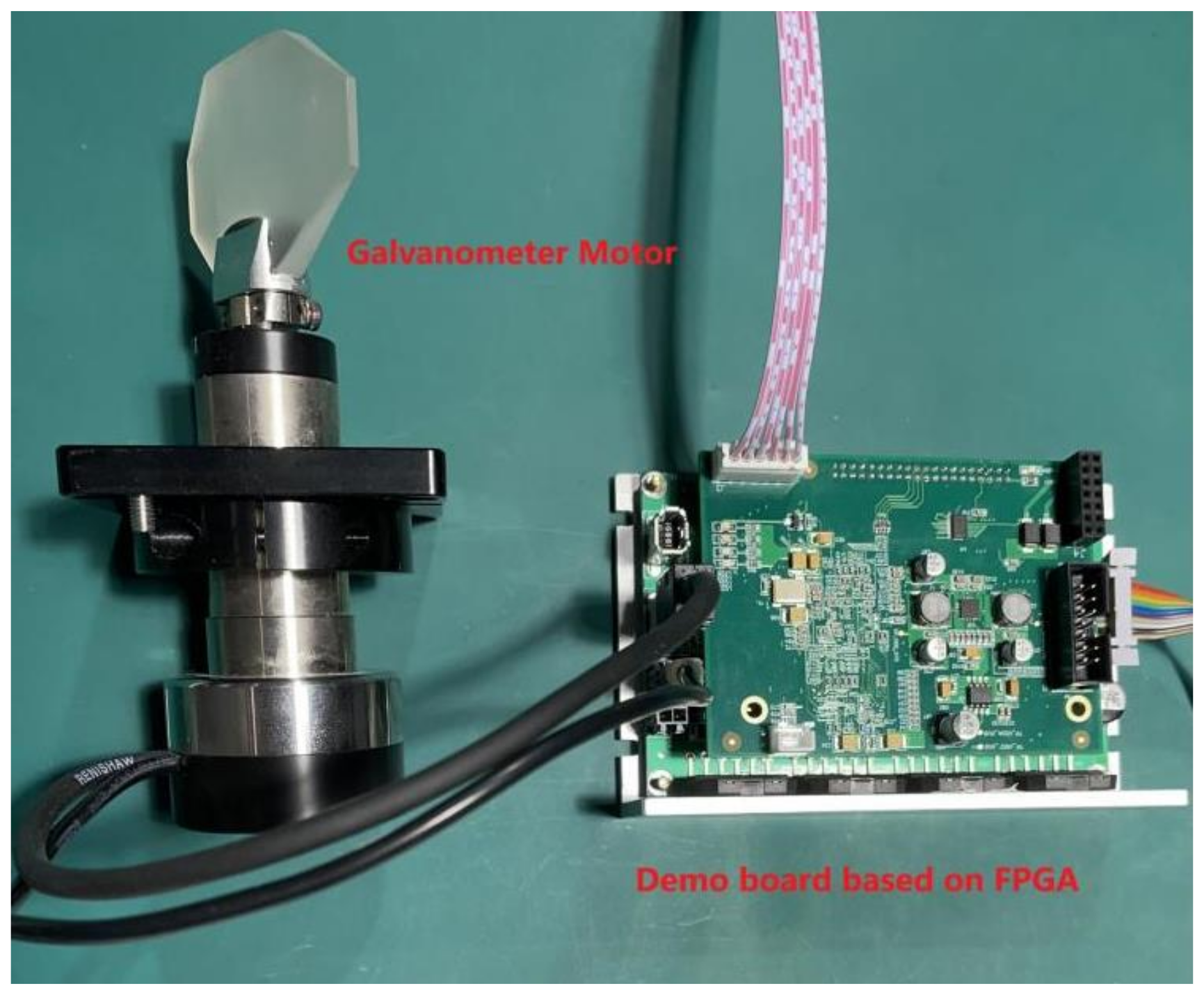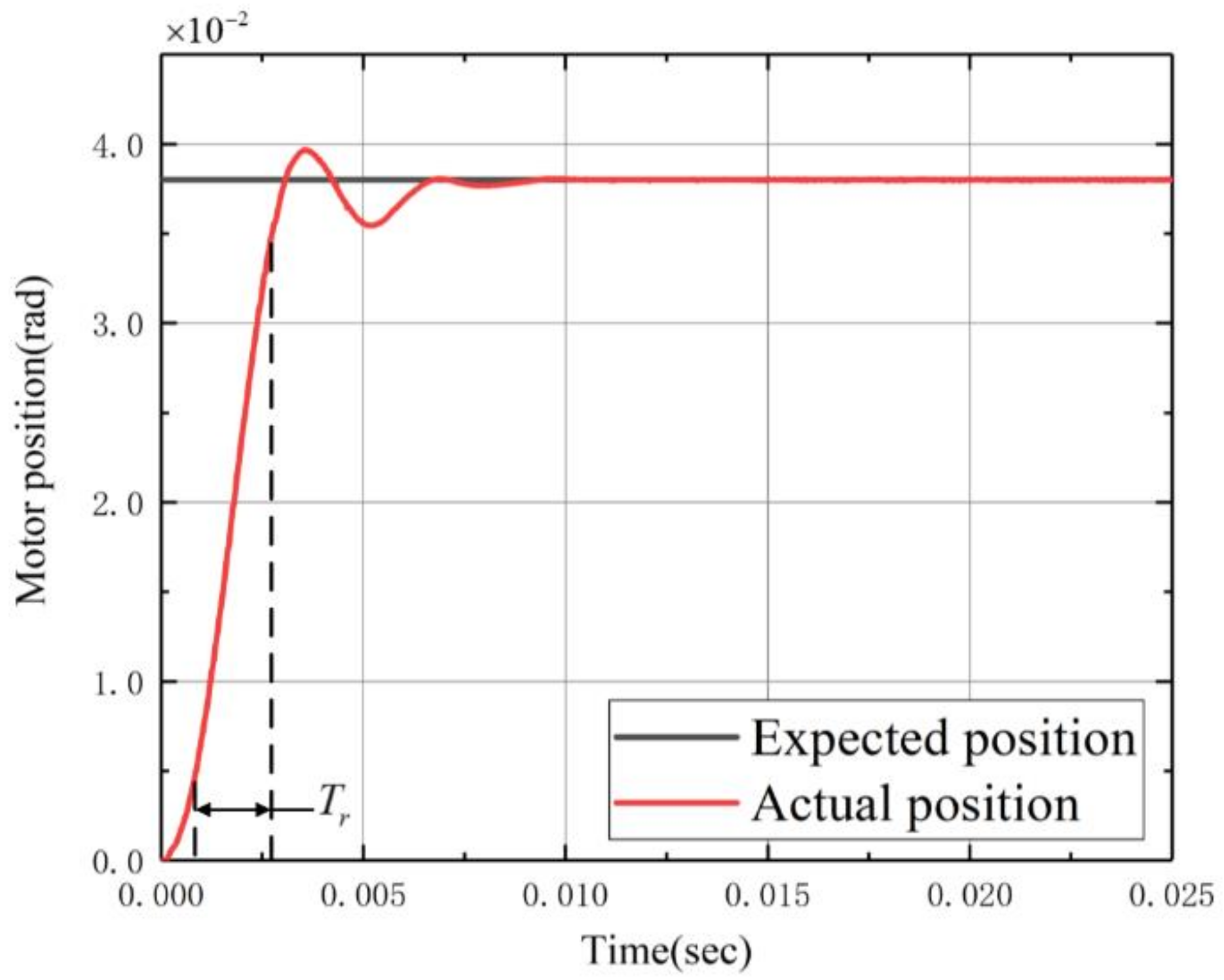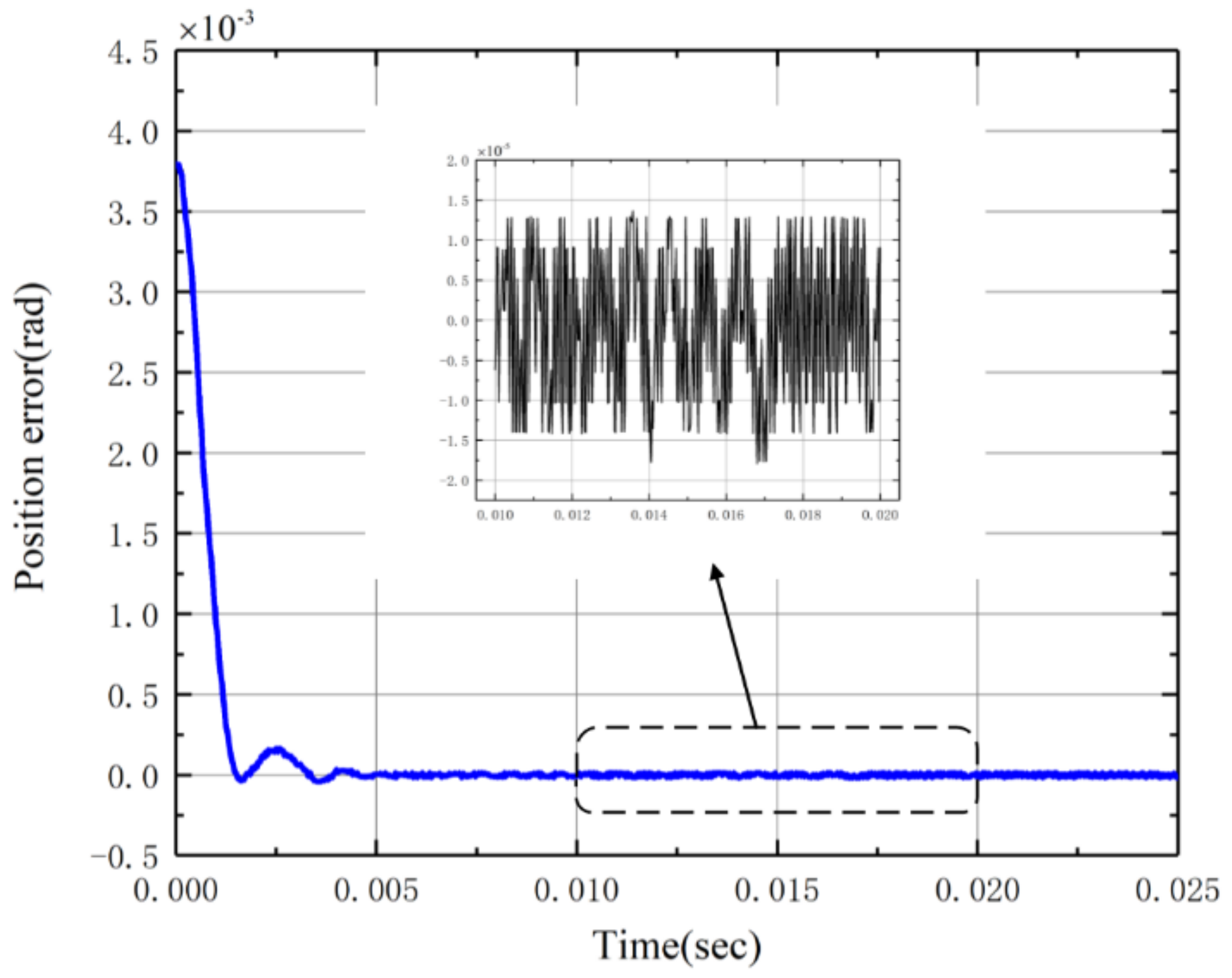Control of a Digital Galvanometer Scanner Using a Discrete-Time Sliding-Mode Variable-Structure Controller Based on a Decoupled Disturbance Compensator
Abstract
:1. Introduction
2. Mathematical Methods and Experimental Details
2.1. Mathematical Model of the Motor of the GS
2.2. Design of the DSVC+DDC
2.3. Experimental Details
3. Results and Discussion
4. Conclusions
Author Contributions
Funding
Institutional Review Board Statement
Informed Consent Statement
Acknowledgments
Conflicts of Interest
References
- Jiang, H.H. Development and prospect of laser machining technology application. J. Atmos. Environ. Opt. 2001, 4, 1–12. [Google Scholar]
- Sabo, D.A.; Brunner, D.; Engelmayer, A. Advantages of digital servo amplifiers for control of a galvanometer based optical scanning system. In Optical Scanning 2005; International Society for Optics and Photonics: San Diego, CA, USA, 2005; Volume 5837, pp. 113–120. [Google Scholar]
- Liu, W.; Liu, D.; Wu, J.; Chang, K.; Chou, M.; Fu, L. Precision sinusoidal tracking for galvanometer scanner with smith pre-dictor-based adaptive sliding mode control. In Proceedings of the 2016 International Automatic Control Conference (CACS), Taichung, Taiwan, 11 September 2016; pp. 100–105. [Google Scholar]
- Yoo, H.W.; Ito, S.; Verhaegen, M.; Schitter, G. Transformation-based iterative learning control for non-collocated sensing of a galvanometer scanner. In Proceedings of the 2013 European Control Conference (ECC), Zurich, Switzerland, 17 July 2013; pp. 1204–1209. [Google Scholar]
- Yoo, H.W.; Ito, S.; Schitter, G. High speed laser scanning microscopy by iterative learning control of a galvanometer scanner. Control Eng. Pract. 2016, 50, 12–21. [Google Scholar] [CrossRef]
- Ito, S.; Yoo, H.W.; Schitter, G. Noise reduction of learning control for periodic motion of galvanometer scanner. IFAC Pap. 2020, 53, 8401–8406. [Google Scholar] [CrossRef]
- Mnerie, C.A.; Preitl, S.; Duma, V.-F. Performance enhancement of galvanometer scanners using extended control structures. In Proceedings of the 2013 IEEE 8th International Symposium on Applied Computational Intelligence and Informatics (SACI), Timisoara, Romania, 23 May 2013; pp. 127–130. [Google Scholar]
- Mnerie, C.A.; Preitl, S.; Duma, V.-F. Classical PID versus predictive control solutions for a galvanometer-based scanner. In Proceedings of the 2015 IEEE 10th Jubilee International Symposium on Applied Computational Intelligence and Informatics, Timisoara, Romania, 21 May 2015; pp. 349–353. [Google Scholar]
- Pieczona, S.J.; Zollitsch, S.; Zaeh, M.F. Dynamics enhancement of galvanometer laser scanners by adaptive inverse control. In Proceedings of the 2017 IEEE International Conference on Advanced Intelligent Mechatronics (AIM), Munich, Germany, 3 July 2017; pp. 253–258. [Google Scholar]
- Zaeh, M.; Pieczona, S. Adaptive inverse control of a galvanometer scanner considering the structural dynamic behavior. CIRP Ann. 2018, 67, 385–388. [Google Scholar] [CrossRef]
- Xiao, H.; Chen, X. Multi-band beyond-Nyquist disturbance rejection on a galvanometer scanner system. In Proceedings of the 2017 IEEE International Conference on Advanced Intelligent Mechatronics (AIM), Munich, Germany, 7 July 2017; pp. 1700–1705. [Google Scholar]
- Qin, W.Y.; Guo, H.; Xu, J.Q.; Liu, L.M. High precision position control based on active disturbance rejection control for galvanometer scanner system. In Proceedings of the 2019 2nd International Conference on Electrical Machines and Systems (ICEMS 2019), Harbin, China, 11 August 2019; pp. 353–356. [Google Scholar]
- Liu, J.K.; Sun, F.C. Research and development of sliding mode variable structure control theory and algorithm. Control Theory Appl. 2007, 24, 407–418. [Google Scholar]
- Marshall, G.; Stutz, G. Handbook of Optical and Laser Scanning, 2nd ed.; CRC Press: Boca Raton, FL, USA, 2011. [Google Scholar]
- Erkorkmaz, K.; Altintas, Y. High speed CNC system design. Part II: Modeling and identification of feed drives. Int. J. Mach. Tools Manuf. 2001, 41, 1487–1509. [Google Scholar] [CrossRef]
- Eun, Y.; Kim, J.-H.; Kim, K.; Cho, D.-I. Discrete-time variable structure controller with a decoupled disturbance compensator and its application to a CNC servomechanism. IEEE Trans. Control Syst. Technol. 1999, 7, 414–423. [Google Scholar] [CrossRef]
- Zhang, K.; Su, H.; Zhuang, K.; Chu, J. Comments on discrete-time variable structure controller with a decou-pled disturbance compensator and its application to a CNC servomechanism. IEEE Trans. Control Syst. Technol. 2003, 11, 156–157. [Google Scholar] [CrossRef]
- Eun, Y.; Kim, J.-H.; Kim, K.; Dan, D.; Cho, D. Reply to Discrete-time variable structure controller with a decoupled disturbance compensator and its application to a CNC servomechanism. IEEE Trans. Control Syst. Technol. 2003, 11, 157. [Google Scholar]
- Chao, C.; Wang, W.; Zhang, W. A discrete model reference sliding mode controller with a disturbance compen-sator and its application to flight simulator. In Proceedings of the 6th Chinese Control and Decision Conference (2014 CCDC), Chongqing, China, 31 May 2014; pp. 3445–3449. [Google Scholar]
- Hou, J.; Yuan, Z.; Zhang, Q.; Wu, M. Sliding mode controller with a disturbance compensator for ce-ment combined grinding system. In Proceedings of the Chinese Automation Congress (CAC), Wuhan, China, 27 November 2015; pp. 196–201. [Google Scholar]
- Han, J.-S.; Kim, T.-I.; Park, J.-H.; Oh, T.-H.; Lee, J.-H.; Kim, S.-O.; Lee, S.-S.; Lee, S.-H.; Cho, D.-I.D. Gain selection method for robustness enhancement in sliding mode control combined with decoupled disturbance com-pensator with unknown inertia in industrial servo systems. In Proceedings of the 2017 17th International Conference on Control Automation and Systems (ICCAS), Jeju, Korea, 18 October 2017; pp. 1713–1717. [Google Scholar]
- Lee, H.; Utkin, V.I. Chattering suppression methods in sliding mode control systems. Annu. Rev. Control 2007, 31, 179–188. [Google Scholar] [CrossRef]
- Du, H.; Yu, X.; Chen, M.Z.; Li, S. Chattering-free discrete-time sliding mode control. Automatica 2016, 68, 87–91. [Google Scholar] [CrossRef]
- O’Toole, M.D.; Bouazza-Marouf, K.; Kerr, D. Chatter suppression in sliding mode control: Strategies and tuning methods. In Examples to Extremum and Variational Principles in Mechanics; Gabler: Berlin, Germany, 2010; pp. 109–116. [Google Scholar]
- Shi, S.L.; Li, J.X.; Fang, Y.M. Extended-state-observer-based chattering free sliding mode control for nonlinear sys-tems with mismatched disturbance. IEEE Access 2018, 6, 22952–22957. [Google Scholar] [CrossRef]
- Svecko, R.; Gleich, D.; Sarjas, A. The effective chattering suppression technique with adaptive su-per-twisted sliding mode controller based on the quasi-barrier function; An experimentation setup. Appl. Sci. 2020, 10, 595. [Google Scholar] [CrossRef] [Green Version]
- Hansscanner.com. Available online: http://hansscanner.com/cpzx/list_2.aspx?lcid=10 (accessed on 12 October 2021).






| Performance Index | Value |
|---|---|
| Step-response time for 1% of the whole stroke (ms) | |
| Step-response time for 10% of the whole stroke (ms) |
| Parameter | Value |
|---|---|
| Power amplification coefficient | |
| Motor torque | |
| Resistance | |
| Rotational inertia | |
| Viscous damping coefficient | |
| Rotation range of the motor |
| Parameter | Value |
|---|---|
| [80 1]T | |
Publisher’s Note: MDPI stays neutral with regard to jurisdictional claims in published maps and institutional affiliations. |
© 2021 by the authors. Licensee MDPI, Basel, Switzerland. This article is an open access article distributed under the terms and conditions of the Creative Commons Attribution (CC BY) license (https://creativecommons.org/licenses/by/4.0/).
Share and Cite
Chen, G.; Wang, Y. Control of a Digital Galvanometer Scanner Using a Discrete-Time Sliding-Mode Variable-Structure Controller Based on a Decoupled Disturbance Compensator. Appl. Sci. 2021, 11, 9788. https://doi.org/10.3390/app11219788
Chen G, Wang Y. Control of a Digital Galvanometer Scanner Using a Discrete-Time Sliding-Mode Variable-Structure Controller Based on a Decoupled Disturbance Compensator. Applied Sciences. 2021; 11(21):9788. https://doi.org/10.3390/app11219788
Chicago/Turabian StyleChen, Guangsheng, and Yunlong Wang. 2021. "Control of a Digital Galvanometer Scanner Using a Discrete-Time Sliding-Mode Variable-Structure Controller Based on a Decoupled Disturbance Compensator" Applied Sciences 11, no. 21: 9788. https://doi.org/10.3390/app11219788
APA StyleChen, G., & Wang, Y. (2021). Control of a Digital Galvanometer Scanner Using a Discrete-Time Sliding-Mode Variable-Structure Controller Based on a Decoupled Disturbance Compensator. Applied Sciences, 11(21), 9788. https://doi.org/10.3390/app11219788





